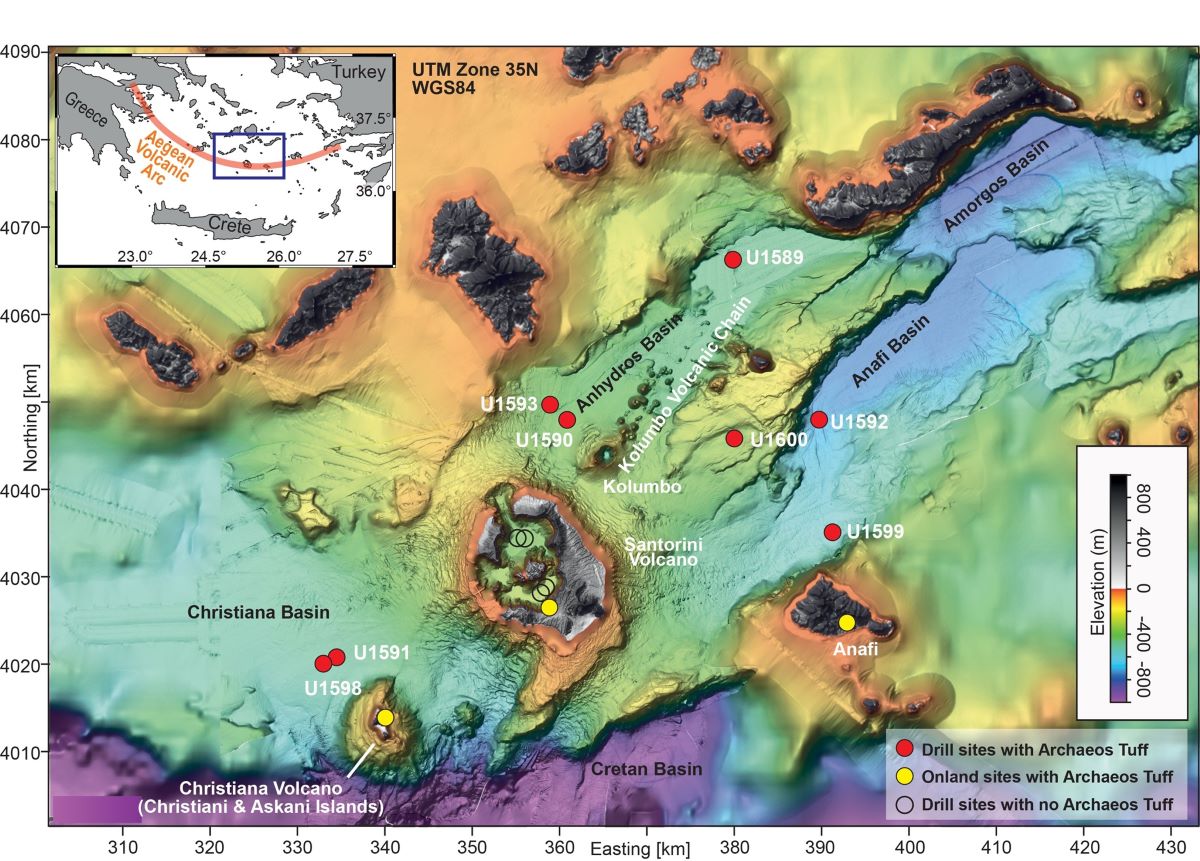
A previously unknown underwater volcano eruption off Santorini, six times larger and 520,000 years older than the Minoan eruption, has been discovered by an international scientific team. A professor from the University of Athens was also on the team.
The underwater Santorini volcano eruption was one of the largest in the volcanic arc of the southern Aegean. An expedition carried out by the research vessel JOIDES Resolution Science Operator brought the eruption to light. The research program International Ocean Discovery Program maintains and runs the particular vessel.
The team identified a huge pumice, or volcanic rock, deposit. They drew samples from this at seven underwater locations around the island of Santorini.
The results of the study have been published in a subset of Nature, titled Communications Earth & Environment.
According to local media, the pumice layer, colloquially referred to as “ancient tophos,” points to a shallow underwater eruption of the prehistoric volcano of Santorini that took place around 520,000 years ago. This is with a possible deviation of 10,000 years.
Santorini’s Ancient Underwater Volcano Eruption Explained
Thin layers of volcanic pumice deposits that were fired from the eruption covered three islands in the area.
The pyroclastic flows discharged under the sea, carried water away and turned into currents of turbidity and mud that covered the seabed up to 70km from their source, forming a submarine deposit with a volume of more than about 90 cubic kilometers and a thickness of up to 150 meters.
This deposit is six times larger than the pyroclastic flow deposits of the great Minoan explosion that occurred during the Late Bronze Age (about 3,600 years ago) and contributed to the decline of the Minoan civilization of Crete.
A Phys.org article on the same study claims that the volcanic field in the Greek Aegean is made up of a sixty-kilometer chain of more than twenty volcanoes, the majority of which are underwater. According to the article, the area is considered especially dangerous because the volcanoes there have a history of eruptions, a number of which have been highly explosive.
However, the research team highlighted that although the area has a violent ancient history of natural disasters, it is very unlikely that the Christiana-Santorini-Kolumbo volcanic field will experience another eruption of such high magnitudes any time in the near future.
Santorini Ancient Underwater Volcano Eruption Dwarfs Recent Events
The team noted the relative size of the ancient eruption, drawing comparisons with the volcanic eruption of January 2022 on the island of Hunga Tonga-Hunga Ha’apai in the Pacific Ocean. The experts explained that these more recent events were ten times smaller than the ancient eruption on Santorini.
The research project is supported by 22 countries and aims to explore the history and structure of the earth as recorded in the sediments and rocks of the seafloor.
Furthermore this oceanographic mission number 398, conducted from December 2022 to February 2023, involved 32 scientists from nine countries, led by Tim Druitt from the French University of Clermont Auvergne, and Stephen Kuterolf from the Geomar Helmholtz Centre for Oceanographic Research in Kiel.
The scientific team, reported the journal, included the associate professor of the Department of Geology and Geoenvironment of the National and Kapodistrian University of Athens, Paraskevi Nomikou, the lecturer at the Department of Geology of the Aristotle University of Thessaloniki, Olga Koukousioura, and the researcher of the Environmental Microbiology Department of the Hellenic Marine Research Centre, Paraskevi Polymenakou.
“The geological history of Santorini is being rewritten,” Nomikou told Amna.
See all the latest news from Greece and the world at Greekreporter.com. Contact our newsroom to report an update or send your story, photos and videos. Follow GR on Google News and subscribe here to our daily email!



